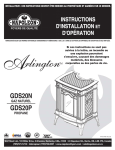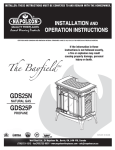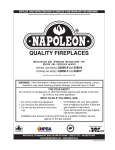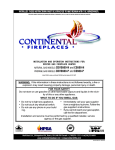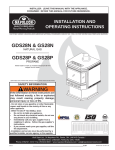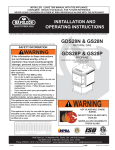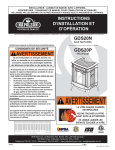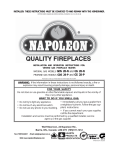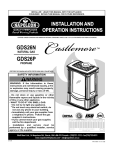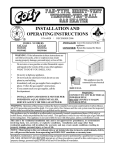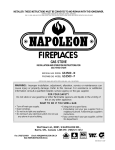Download Napoleon Fireplaces GDS 50-N User's Manual
Transcript
1 INSTALLER: THESE INSTRUCTIONS MUST BE CONVEYED TO AND REMAIN WITH THE HOMEOWNER. CERTIFIED UNDER CANADIAN AND AMERICAN NATIONAL STANDARDS, CSA 2.33, ANSI Z21.88 FOR VENTED GAS FIREPLACE HEATERS GAS-FIRED STOVES INSTALLATION AND OPERATION INSTRUCTIONS FOR: VENTED GAS FIREPLACE HEATER NATURAL GAS MODELS PROPANE GAS MODELS GDS 50-N GDS 50-P NATURAL GAS MODEL GS 50-N PROPANE GAS MODEL GS 50-P CERTIFIED FOR CANADA AND UNITED STATES USING ANSI / CSA METHODS WARNING: If the information in these instructions is not followed exactly, a fire or explosion may result causing property damage, personal injury or death. FOR YOUR SAFETY Do not store or use gasoline or other flammable vapours and liquids in the vicinity of this or any other appliance. WHAT TO DO IF YOU SMELL GAS: • Immediately call your gas supplier from a • Do not try to light any appliance. neighbour's phone. Follow the gas supplier's • Do not touch any electrical switch. instructions. • Do not use any phone in your building. • If you cannot reach your gas supplier, call the fire department. Installation and service must be performed by a qualified installer, service agency or the gas supplier. Wolf Steel Ltd., 24 Napoleon Rd., Barrie, ON L4M 4Y8 Canada • (705)721-1212 • fax(705)722-6031 www.napoleonfireplaces.com • [email protected] W415-0098 / C / 04.19.06 2 TABLE of CONTENTS Pg 2-4 INTRODUCTION Warranty General Instructions General Information Care of Glass & Plated Parts 5 Pg 14 15-16 FINISHING Door Opening & Closing Louvre & Trivet Installation Mantle Clearances Log Placement LOCATION & CLEARANCES 6-11 DIRECT VENT SPECIFICS MODEL GDS50 Vent Lengths/Air Terminal Locations Special Installation Example Offset Installation Example Wall & Ceiling Protection Horizontal Venting Installation Vertical Venting Installation Stove Vent Connection Mobile Home Installation 12-14 B-VENT SPECIFICS MODEL GS50 Chimney Installation 'B' Vent Installation Adding Vent Sections Flashing and Storm Collar Installation 'B' Vent Adaptations Combustion Air GAS INSTALLATION 17-18 OPERATION / MAINTENANCE Spill Switch Turbo Burner Operating Instructions Maintenance 19 REPLACEMENT BLOWER 20 ADJUSTMENTS Pilot Burner Adjustment Venturi Adjustments 21-22 REPLACEMENTS Ordering Replacement Parts Terminal Kits Accessories Replacement Parts 23-24 TROUBLE SHOOTING GUIDE PLEASE RETAIN THIS MANUAL FOR FUTURE REFERENCE WARNING • The stove is a vented gas-fired heater. Do not burn wood or other materials in this stove. • Adults and especially children should be alerted to the hazards of high surface temperatures and should stay away to avoid burns or clothing ignition. Supervise young children when they are in the same room as the stove. • Due to high temperatures, the stove should be located out of traffic and away from furniture and draperies. • Clothing or other flammable material should not be placed on or near the stove. • Any safety screen or guard removed for servicing must be replaced prior to operating the stove. • It is imperative that the control compartments, burners and circulating blower and its passageway in the stove and venting system are kept clean. The stove and its venting system should be inspected before use and at least annually by a qualified service person. More frequent cleaning may be required due to excessive lint from carpeting, bedding material, etc. The stove area must be kept clear and free from combustible materials, gaso line and other flammable vapours and liquids. • Under no circumstances should this stove be modified. • This stove must not be connected to a chimney flue pipe serving a separate solid fuel burning appliance. • Do not use this stove if any part has been under water. Immediately call a qualified service technician to inspect the stove and to replace any part of the control system and any gas control which has been under water. • Do not operate the stove with the glass door opened, cracked or broken. Replacement of the glass should be done by a licensed or qualified service person. • Do not strike or slam shut the stove glass door. • This fireplace uses and requires a fast acting thermocouple. Replace only with a fast acting thermocouple supplied by Wolf Steel Ltd. • Adults and especially children should be alerted to the hazards of high surface temperatures and should stay away to avoid burns or clothing ignition. Keep young children and animals away when the fireplace is hot. W415-0098 / C / 04.19.06 3 NAPOLEON products are manufactured under the strict Standard of the world recognized ISO 9001 : 2000 Quality Assurance Certificate. NAPOLEON products are designed with superior components and materials, assembled by trained craftsmen who take great pride in their work. The burner and valve assembly are leak and test-fired at a quality test station. The complete fireplace is test-fired again and thoroughly inspected by a qualified technician before packaging to ensure that you, the customer, receives the quality product that you expect from NAPOLEON. NAPOLEON GAS FIREPLACE PRESIDENT'S LIFETIME LIMITED WARRANTY The following materials and workmanship in your new NAPOLEON gas fireplace are warranted against defects for as long as you own the fireplace. This covers: combustion chamber, heat exchanger, stainless steel burner, phazer™ logs and embers, ceramic glass (thermal breakage only), gold plated parts against tarnishing, porcelainized enamelled components and aluminum extrusion trims. Electrical (110V and millivolt) components and wearable parts such as blowers, gas valves, thermal switch, switches, wiring, remote controls, ignitor, gasketing, and pilot assembly are covered and NAPOLEON will provide replacement parts free of charge during the first year of the limited warranty. Labour related to warranty repair is covered free of charge during the first year. Repair work, however, requires the prior approval of an authorized company official. Labour costs to the account of NAPOLEON are based on a predetermined rate schedule and any repair work must be done through an authorized NAPOLEON dealer. CONDITIONS AND LIMITATIONS NAPOLEON warrants its products against manufacturing defects to the original purchaser only -- i.e., the individual or legal entity (registered customer) whose name appears on the warranty registration card filed with NAPOLEON -- provided that the purchase was made through an authorized NAPOLEON dealer and is subject to the following conditions and limitations: This factory warranty is nontransferable and may not be extended whatsoever by any of our representatives. The gas fireplace must be installed by a licenced, authorized service technician or contractor. Installation must be done in accordance with the installation instructions included with the product and all local and national building and fire codes. This limited warranty does not cover damages caused by misuse, lack of maintenance, accident, alterations, abuse or neglect and parts installed from other manufacturers will nullify this warranty. This limited warranty further does not cover any scratches, dents, corrosion or discolouring caused by excessive heat, abrasive and chemical cleaners nor chipping on porcelain enamel parts, mechanical breakage of PHAZER™ logs and embers, nor any venting components used in the installation of the fireplace. NAPOLEON warrants its stainless steel burners against defects in workmanship and material for life, subject to the following conditions: During the first 10 years NAPOLEON will replace or repair the defective parts at our option free of charge. From 10 years to life, NAPOLEON will provide replacement burners at 50% of the current retail price. In the first year only, this warranty extends to the repair or replacement of warranted parts which are defective in material or workmanship provided that the product has been operated in accordance with the operation instructions and under normal conditions. After the first year, with respect to this President's Limited Lifetime Warranty, NAPOLEON may, at its discretion, fully discharge all obligations with respect to this warranty by refunding to the original warranted purchaser the wholesale price of any warranted but defective part(s). After the first year, NAPOLEON will not be responsible for installation, labour or any other costs or expenses related to the reinstallation of a warranted part, and such expenses are not covered by this warranty. Notwithstanding any provisions contained in this President's Limited Lifetime Warranty, NAPOLEON’S responsibility under this warranty is defined as above and it shall not in any event extend to any incidental, consequential or indirect damages. This warranty defines the obligations and liability of NAPOLEON with respect to the NAPOLEON gas fireplace and any other warranties expressed or implied with respect to this product, its components or accessories are excluded. NAPOLEON neither assumes, nor authorizes any third party to assume, on its behalf, any other liabilities with respect to the sale of this product. NAPOLEON will not be responsible for: over-firing, downdrafts, spillage caused by environmental conditions such as rooftops, buildings, nearby trees, hills, mountains, inadequate vents or ventilation, excessive venting configurations, insufficient makeup air, or negative air pressures which may or may not be caused by mechanical systems such as exhaust fans, furnaces, clothes dryers, etc. Any damages to fireplace, combustion chamber, heat exchanger, brass trim or other component due to water, weather damage, long periods of dampness, condensation, damaging chemicals or cleaners will not be the responsibility of NAPOLEON. The bill of sale or copy will be required together with a serial number and a model number when making any warranty claims from your authorized dealer. The warranty registration card must be returned within fourteen days to register the warranty. NAPOLEON reserves the right to have its representative inspect any product or part thereof prior to honouring any warranty claim. ALL SPECIFICATIONS AND DESIGNS ARE SUBJECT TO CHANGE WITHOUT PRIOR NOTICE DUE TO ON-GOING PRODUCT IMPROVEMENTS. NAPOLEON® IS A REGISTERED TRADEMARK OF WOLF STEEL LTD. PATENTS U.S. 5.303.693.801 - CAN. 2.073.411, 2.082.915 & DES 417,497(12.07.1999). © WOLF STEEL LTD. W415-0098 / C / 04.19.06 4 GENERAL INSTRUCTIONS GENERAL INFORMATION THIS GAS STOVE SHOULD BE INSTALLED AND SERVICED BY A QUALIFIED INSTALLER to conform with local codes. Installation practices vary from region to region and it is important to know the specifics that apply to your area, for example: in Massachusetts State: FOR YOUR SATISFACTION, THIS STOVE HAS BEEN TEST-FIRED TO ASSURE ITS OPERATION AND QUALITY! Minimum inlet gas supply pressure is 4.5 inches water column for natural gas and 11 inches water column for propane. Maximum inlet gas pressure is 7 inches water column for natural gas and 13 inches water column for propane. Manifold pressure under flow conditions is 3.5 inches water column for natural gas and 10 inches water column for propane. For elevations between 2,000 and 4,500 feet above sea level, this fireplace must be de-rated by 10% using the certified high altitude kit. When the fireplace is installed at elevations above 4,500ft, and in the absense of specific recommendations from the local authority having jurisdiction, the certified high altitude input rating shall be reduced at the rate of 4% for each additional 1,000ft. Change in flame appearance from "HI" to "LO" is more evident in natural gas than in propane. Expansion / contraction noises during heating up and cooling down cycles are normal and to be expected. • The fireplace damper must be removed or welded in the open posiiton prior to installation of a fireplace insert or gas log. • The appliance off valve must be a “T” handle gas cock. • The flexible connector must not be longer than 36 inches. • The appliance is not approved for installation in a bedroom or bathroom unless the unit is a direct vent sealed combustion product. • A carbon monoxide detector is required in all rooms containing gas fired appliances • WARNING: This product must be installed by a licensed plumber or gas fitter when installed within the commonwealth of Massachusetts. In absence of local codes, install to the current CAN1-B149 Installation Code in Canada or to the National Fuel Gas Code, ANSI Z223.1, and NFPA 54 in the United States. Mobile home installation must conform with local codes or in the absence of local codes, install to the current standard for gas equipped mobile housing CAN/CSA Z240 MH Series in Canada or ANSI Z223.1and NFPA 54 in the United States. Purge all gas lines with the glass door of the stove opened. Assure that a continuous gas flow is at the burner before closing the door. Under extreme vent configurations, allow several minutes (5-15) for the flame to stabilize after ignition. All horizontal runs must have a ¼ inch rise per foot. Objects placed in front of the fireplace must be kept a minimum of 48" away from the front face of the unit. The stove and its individual shutoff valve must be disconnected from the gas supply piping system during any pressure testing of that system at test pressures in excess of 1/ 2 psig (3.5 kPa). The stove must be isolated from the gas supply piping system by closing its individual manual shutoff valve during any pressure testing of the gas supply piping system at test pressures equal to or less than 1/2 psig (3.5 kPa). A 1/8 inch NPT plug, accessible for test gauge connection, must be installed immediately upstream of the gas supply connection to the stove. The stove, when installed with a blower, must be electrically connected and grounded in accordance with local codes. In the absence of local codes, use the current CSA C22.1 CANADIAN ELECTRICAL CODE in Canada or the ANSI/NFPA 70-1990 NATIONAL ELECTRICAL CODE in the United States. The blower power cord must be connected into a properly grounded receptacle. The grounding prong must not be removed from the cord plug. W415-0098 / C / 04.19.06 GDS50: Maximum input is 44,000 BTU/hr for natural gas and 40,000 BTU/hr for propane. Maximum output for natural gas is 37,000 BTU/hr at an efficiency of 84% with the fan on; Maximum output for propane is 34,400 BTU/hr at an efficiency of 86% with the fan on. Maximum A.F.U.E. (annual fuel utilization efficiency) rating is 77% for natural gas and 79% for propane. This stove is not approved for closet or recessed installations. It is approved for bathroom, bedroom and bed-sitting room installations and is suitable for mobile homes. The natural gas model is suitable for installation in a mobile home that is permanently positioned on its site and fueled with natural gas. GS50: Maximum input is 44,000 BTU/hr for natural gas and 40,000 BTU/hr for propane. Maximum output for natural gas is 31,200 BTU/ hr at an efficiency of 77% with the fan on and 71% with the fan off; and 30,000 BTU/hr for propane at an efficiency of 78% with the fan on and 73% with the fan off. Minimum A.F.U.E. (annual fuel utilization efficiency) rating is 65% for natural gas and 67% for propane. This stove is approved for bedroom and bed-sitting room installations. CARE OF GLASS, AND PLATED PARTS Do not use abrasive cleaners to clean these parts. Buff lightly with a clean dry cloth. The glass is 3/16" ceramic glass available from your Napoleon / Wolf Steel Ltd. dealer. DO NOT SUBSTITUTE MATERIALS. Clean the glass after the first 10 hours of operation with a recommended gas fireplace glass cleaner. Thereafter clean as required. DO NOT CLEAN GLASS WHEN HOT! If the glass is not kept clean permanent discolouration and / or blemishes may result. 5 LOCATION & CLEARANCES Provide adequate ventilation and combustion air. Provide adequate accessibility clearance for servicing and operating the stove. Never obstruct the front opening of the stove. Objects placed in front of the fireplace must be kept a minimum of 48" away from the front face of the unit. GDS50 AND GS50 As long as clearance to combustibles is kept within the required distances, the most desirable and benefical location for a Napoleon stove is in the centre of a building, thereby allowing the most efficient use of the heat created. The location of windows, doors and the traffic flow in the room where the stove is to be located should be considered. If possible, you should choose a location where the vent will pass through the house without cutting a floor or roof joist. 21-5/8" 28¼" 14-1/8" 4"ø FLUE FIGURE 1 8" 7"ø AIR INTAKE 11" 16-7/8" WINDOW OPENING 13-3/4" 21" 30-3/4" GAS LINE LOCATED IN PEDESTAL REAR FIGURE 2 W415-0098 / C / 04.19.06 6 DIRECT VENT SPECIFICS - MODEL GDS50 VENTING LENGTHS & AIR TERMINAL LOCATIONS Use only Wolf Steel, Simpson Dura-Vent, Selkirk Direct Temp or American Metal Amerivent venting components. Minimum and maximum vent lengths, for both horizontal and vertical installations, and air terminal locations for either system are set out in this manual and must be adhered to. For Simpson Dura-Vent, Selkirk Direct Temp and American Metal Amerivent, follow the installation procedure provided with the venting components. For vent systems that provide seals on the inner exhaust flue, only the outer air intake joints must be sealed using a red high temperature silicone (RTV). This same sealant maybe used on both the inner exhaust and outer intake vent pipe joints of all other approved vent systems except for the exhaust vent pipe connection to the fireplace flue collar which must be sealed using the black high temperature sealant Mill Pac. High temperature sealant must be ordered separately. Wolf Steel, Simpson Dura-Vent, Selkirk Direct Temp and American Metal Amerivent venting systems must not be combined. For optimum flame appearance and stove performance, keep the vent length and number of elbows to a minimum. On extreme vent configurations, allow several minutes (5-15) for the flame to stabilize after lighting. The air terminal must remain unobstructed at all times. Examine the air terminal at least once a year to verify that it is unobstructed and FIGURE 4 undamaged. The maximum horizontal run is 34 inches with a 90o elbow located 29" above the stove. FIGURE 4. The maximum horizontal run with a 57 inch vertical rise immediately above the stove is 20 feet FIGURE 5. A starter adaptor must be used and may be purchased from the corresponding supplier: Supplier GAS STOVE Dura-Vent GDS924N Amerivent 4DSCB-N1 Direct Temp 4DT-AAN When using Napoleon venting components, use only the following vent kits: WALL TERMINAL KIT GD175 (7-1/2' of venting included), or 1/12 TO 7/12 PITCH ROOF TERMINAL KIT GD110, 8/12 TO 12/12 ROOF TERMINAL KIT GD111, FLAT ROOF TERMINAL KIT GD112 or STOVE PERISCOPE KIT GD180 (for wall penetration below grade) in conjunction with the appropriate venting components. FIGURE 3 These vent kits allow for either horizontal or vertical venting of the stove. FIGURES 4, 5, & 6. The maximum number of 4" flexible connections is two horizontally or three vertically (excluding the stove and the air terminal connections). When terminating vertically, the minimum vertical rise is 34 inches above the stove and the maximum vertical rise is 40 feet. FIGURE 3. Deviation from the minimum vertical vent length can create difficulty in burner start-up and/or carboning. Use an adjustable pipe as the final length of rigid piping to the stove for ease of installation. We recommend that exhaust vents that pass through unheated spaces be wrapped in a protective sleeve to minimize condensation and reverse flow symptoms. See Trouble Shooting for details. W415-0098 / C / 04.19.06 FIGS 5 HORIZONTAL RUN NOT TO EXCEED VERTICAL RISE 180 IF VERTICAL RISES GREATER THAN 57 INCHES ARE NECESSARY, THE INCREASED RISE MUST BE DEDUCTED FROM THE HORIZONTAL RUN. A terminal shall not terminate directly above a sidewalk or paved driveway which is located betweeen two single family dwellings and serves both dwellings. Local codes or regulations may require different clearances. Do not allow the inside liner to bunch up on horizontal or vertical runs and elbows. Keep it pulled tight. a 1-1/4" air gap all around between the inner liner and outer stove pipe is required for safe operation. Use a firestop when penetrating interior walls, floor or ceiling. All horizontal runs must have a minimum ¼ inch rise per foot. 7 AIR TERMINAL LOCATIONS FIGURE 6 INSTALLATIONS CANADIAN U.S.A. A 12 INCHES 12 INCHES B 12 INCHES 9 INCHES Clearance to windows or doors that open. C 12 INCHES* 12 INCHES* Clearance to permanently closed windows. D 18 INCHES** 18 INCHES** Vertical clearance to ventilated soffit located above the terminal within a horizontal distance of 2 feet from the centerline of the terminal. E 12 INCHES** 12 INCHES** Clearance to unventilated soffit. F 0 INCHES 0 INCHES 0 INCHES*** 0 INCHES*** Clearance to an inside non-combustible corner wall or protruding non-combustible obstructions (chimney, etc.). 2 INCHES*** 2 INCHES*** Clearance to an inside combustible corner wall or protruding combustible obstructions ( vent chase, etc.). H 3 FEET 3 FEET**** Clearance to each side of the centerline extended above the meter / regulator assembly to a maximum vertical distance of 15ft. I 3 FEET 3 FEET**** Clearance to a service regulator vent outlet. J 12 INCHES 9 INCHES Clearance to a non-mechanical air supply inlet to the building or a combustion air inlet to any other appliance. K 6 FEET 3 FEET† L 7 FEET‡ 7 FEET**** M 12 INCHES†† 12 INCHES**** N 16 INCHES 16 INCHES O 2 FEET†* 2 FEET†* G * ** *** **** † ‡ †† †* Clearance above grade, veranda porch, deck or balcony. Clearance to an outside corner wall. Clearance to a mechanical air supply inlet. Clearance above a paved sidewalk or paved driveway located on public property unless fitted with a heat shield kit GD-301. Clearance under a veranda, porch, deck or balcony. Clearance above the roof. Clearance from an adjacent wall including neighbouring buildings. Recommended to prevent condensation on windows and thermal breakage It is recommended to use a heat shield and to maximize the distance to vinyl clad soffits. The periscope GD-201 requires a minimum 18 inches clearance from an inside corner. This is a recommended distance. For additional requirements check local codes. Three feet above if within 10 feet horizontally. A vent shall not terminate directly above a sidewalk or paved driveway that is located between two single family dwellings and serves both dwellings. Permitted only if the veranda, porch, or deck is fully open on a minimum of two sides beneath the floor. Recommenced to prevent recirculation of exhaust products. For additional requirements check local codes. W415-0098 / C / 04.19.06 8 Use the chart on this page to calculate horizontal runs for vertical rises between 29 and 57 inches. FIGURE 7. OFFSET INSTALLATION EXAMPLE FIGURE 9 When calculating maximum run lengths, include 10 feet for each 90° elbow or 5 feet for each 45° elbow. (DO NOT INCLUDE THE FIRST ELBOW DIRECTLY OFF THE UNIT.) FIGURE 7 REQUIRED VERTICAL RISE FROM FIREPLACE TO FIRST ELBOW IN INCHES CALCULATED HORIZONTAL VENT RUN IN FEET SPECIAL INSTALLATION EXAMPLE When a horizontal run is introduced, even though the terminal may be vertical, the installation must be considered HORIZONTAL. A through the roof installation requires a total 5 foot rise. FIGURE 8. The location of the fireplace dictates a horizontal run of 5 feet. What is the required vertical rise to the centre of the initial 90° elbow? The total run is: 5 ft. (through the roof vertical rise) 10 ft. (90° elbow) 5 ft. (horizontal run) 20 ft. (total run) Using the chart, will determine that a 57 inch minimum vertical rise immediately off the unit is required for satisfactory venting conditions. ALTHOUGH THE IMMEDIATE VERTICAL RUN MAY BE GREATER THAN 57 INCHES, THE MAXIMUM COMBINATION OF HORIZONTAL AND VERTICAL RUNS, BEYOND THE 57 INCHES, MUST NOT EXCEED 20 FEET. FIGURE 8 W415-0098 / C / 04.19.06 48" secon d ru n first run 72" 57" If a first run of 72 inches is required, using the "First Vent Run" on the chart shows that a maximum second run of 48 inches is allowable. IF NECESSARY, THE FIRST RUN AND THE SECOND RUN MAY BE REVERSED. FIGURE 10 9 WALL AND CEILING PROTECTION FOR SAFE AND PROPER OPERATION OF THE STOVE, FOLLOW THE VENTING INSTRUCTIONS EXACTLY. HORIZONTAL INSTALLATION VERTICAL INSTALLATION This application occurs when venting through an exterior wall. FIGURES 5, 6, & 13. Having determined the air terminal location, cut and frame a hole in an exterior wall with a minimum square or round opening of 9". (As an alternative to framing, a vent pipe shield may be installed, ensuring a 1" clearance to combustibles. See FIGURE 11 Figure 11.) THE STOVE PIPE MUST RISE ¼" PER FOOT OF RUN. 1. Mark and cut the vent pipe shield to the determined depth of the combustible wall. Apply a bead of caulking (not supplied) to the framework or to the shield plate (in the case of a finished wall) and secure the shield through the opening to the interior wall. The final location of the vent pipe shield should maintain the required clearance to the 7" vent pipe. Do not fill this cavity with any type of material. This application occurs when venting through a roof. FIGURE 13. Installation kits for various roof pitches are available from your Napoleon dealer. See Accessories to order the specific kit required. 1. Determine the air terminal location and move the stove into position. Cut and frame 9 inch FIGURE 13 openings in the ceiling and the roof to provide the minimum 1 inch clearance between the stove pipe and any combustible material. Try to center the exhaust pipe location midway between two joist to prevent having to cut them. Use a plumb bob to line up the center of the openings. Do not fill this space with any type of material. A vent pipe shield will prevent any materials such as insulation, from filling up the 1" air space around the pipe. FIGURE 15. Nail headers between the joist for extra support. OR FIGURE 14 FIGURE 12 Apply a bead of caulking all around and place a firestop spacer over the vent shield to restrict cold air from being drawn into the room or around the stove. Ensure that both spacer and shield maintain the required clearance to combustibles. Once the vent pipe is installed in its final position, apply sealant between the pipe and the firestop spacer. 2. Apply a bead of caulking (not supplied) to the framework or to the Wolf Steel vent pipe shield plate or equivalent (in the case of a finished ceiling), and secure over the opening in the ceiling. FIGURE 14. A firestop must be placed on the bottom of each framed opening in a roof or ceiling that the venting system passes through. FIGURE 13. Apply a bead of caulking all around and place a firestop spacer over the vent shield to restrict cold air from being drawn into the room or around the stove. Ensure that both spacer and shield maintain the required clearance to combustibles. Once the vent pipe is installed in its final position, apply sealant between the pipe and the firestop spacer. 3. In the attic, slide the vent pipe collar down to cover up the open end of the shield and tighten. This will prevent any materials, such as insulation, from filling up the 1” air space around the pipe. FIGURE 15 W415-0098 / C / 04.19.06 10 HORIZONTAL VENTING INSTALLATION FOR SAFE AND PROPER OPERA TION OF THE OPERATION ST O VE, FOLL O W THE VENTING INSTR UCSTO FOLLO INSTRUCTIONS EXA CTL Y. EXACTL CTLY ALL HORIZONT AL R UNS MUST HA VE A MINIHORIZONTAL RUNS HAVE MUM ¼ INCH RISE PER FOO FOOT T. FIGURE 16 1. Stretch the 4" diameter aluminum flexible liner to the required length taking into account the additional length needed for the finished wall surface. Spacers are attached to the 4" inner flex liner at predetermined intervals to maintain a 1-1/4" air gap to the 7" outer stove pipe. These spacers must not be removed. Slip a 4" diameter length of aluminum flexible liner a minimum of 2" over the inner sleeve of the air terminal. Secure to the sleeve using 3 screws. Seal the joint and screw heads using red RTV or Mill Pac high temperature sealant (not supplied). 2. Slip the first section of 7" diameter stove pipe a minimum of 2" over the outer sleeve of the air terminal. Secure to the sleeve using 3 screws. Seal the joint and screw heads using red RTV high temperature sealant. 3. Insert the liners through the firestop / vent pipe shield. Holding the air terminal (lettering in an upright, readable position), secure to the exterior wall. Make weather tight by sealing with caulking (not supplied). The air terminal mounting plate may be recessed (up to 3/4" maximum) into the exterior wall or siding. FIGURE 17 4. If more than one length of liner needs to be used to reach the stove, couple them together as illustrated in FIGURE 18. Seal the joints using the same procedure as described above. The vent system must be supported approximately every 10 feet along a horizontal run. Use supports or equivalent non-combustible strapping to maintain the 1" clearance from combustibles. W415-0098 / C / 04.19.06 VERTICAL VENTING INSTALLATION FIGURE 18 1. Fasten the roof support to the roof using the screws provided. The roof support is optional. In this case the venting is to be adequately supported using either an alternate method suitable to the authority having jurisdiction or the ROOF SUPPORT optional roof support. FIGURE 19 2. Stretch the inner aluminum flex INNER SLEEVE liner to the required length. Slip the liner a minimum of 2” over the inner sleeve of the air terminal connector AIR and secure with 3 #8 screws. Seal TERMINAL using a heavy bead of the high CONNECTOR temperature sealant. HIGH TEMPERATURE 3. Repeat using the outer aluminum SEALANT INNER FLEX flex liner. LINER 4. Thread the air terminal connector OUTER FLEX LINER / liner assembly down through the roof. The air terminal must be located vertically and plumb. Attach the air DO NOT CLAMP THE FLEXIBLE terminal connector to the roof support, ALUMINIUM ensuring that the top of the air terminal LINER. is 16” above the highest point that it penetrates the roof. 5. Remove nails from the shingles, above and to the sides FIGURE 20 of the chimney. Place the flashing over the air terminal connector AIR INLET leaving a min. 3/4” of the air 2” BASE terminal connector showing above the top of the flashing. CAULKING Slide the flashing STORM COLLAR underneath the sides and WEATHER upper edge of the shingles. SEALANT Ensure that the air terminal connector is properly centred within the flashing, giving a FLASHING 3/4” margin all around. Fasten to the roof. Do not Spacers are attached to nail through the lower the inner flex liner at portion of the flashing. Make predetermined intervals to weather-tight by sealing maintain a 1-1/4” air gap to with caulking. Where possible, cover the sides the outer flex liner. These spacers must not be and top edges of the removed. flashing with roofing material. 6. Aligning the seams of the terminal and air terminal connector, place the terminal over the air terminal connector making sure the liner goes into the hole in the terminal. Secure with the three screws provided. 7. Apply a heavy bead of weatherproof caulking 2 inches above the flashing. Note: Maintain a minimum 2” space between the air inlet base and the storm collar. Install the storm collar around the air terminal and slide down to the caulking. Tighten to ensure that a weather-tight seal between the air terminal and the collar is achieved. 11 STOVE VENT CONNECTION MOBILE HOME INSTALLATION 1. Attach the adFIGURE 21 justable pipe to #8x1/2" the last section of SELF DRILLING rigid piping. SeSCREWS cure with screws 2" OVERLAP and seal. HI-TEMP SEALANT 2. Install the 4" aluminum flexible liner to the stove. ON/OFF Secure with 3 SWITCH screws and flat washers. Seal the VARIABLE joint and screw SPEED SWITCH holes using Mill Pac high temperature sealant not supplied. 3. Run a bead of 14" 5/3 red RTV high tem3/4 2" 5 perature sealant around the inside of the air intake collar. Pull the adjustable pipe a minimum 2" into the air intake collar. In Canada, mobile home installation may be vented horizontally or vertically. In the United States, it may only be installed vertically. See "Vertical Venting" or "Horizontal Air Terminal Installation" for installation. The fireplace is equipped with two 5/16" diameter holes located near each corner of the base. For mobile home installations, the fireplace must be fastened in place. Use #10 screws, inserted through the holes in the base to secure. It is recommended that the fireplace be secured in all installations. Ensure that the sealant is not visible on the exterior pipes once installation is completed. An optional decorative brass band is available for this use. (Standard with a GD175 kit). In the event that the venting must be disassembled, care must be taken to reseal the venting. Continue with "Gas Installation" Page 14 W415-0098 / C / 04.19.06 12 B-VENT SPECIFICS - MODEL GS50 CHIMNEY INSTALLATION INSTALLING 'B' VENT: Three types of chimney systems may be used with this stove: Follow the instructions for "Wall and Ceiling Protection". FIGURE 22 ADAPTER INSTALLATION FIGURE 23 1. Remove the spill switch bracket from the rear of the adapter. 2. Gently pull the two wire terminals (located inside the 7" flue collar at the top of the stove) out approximately 8 inches. 3. Bring the wires through the lower hole in the adapter and out the spill switch opening. To pass the wires through the hole more easily, temporarily tape the two terminals together. 4. With the spill switch opening aligned to the back of the stove, take hold of the adaptor base and push the crimped edge into the stove flue collar. 5. Connect the wire terminals to the spill switch and resecure the bracket. For aesthetics, the adapter has been designed to accept a standard matte black 7" stove pipe and the Napoleon decorative brass band (standard with the GS150KT). Both are available from your Napoleon dealer. ADDING VENT SECTIONS A CHIMNEY VENTING THIS STOVE SHALL NOT VENT ANY SOLID FUEL BURNING APPLIANCE. ALL HORIZONTAL RUNS MUST HAVE A 1/4 INCH RISE PER FOOT. FIGURE 23 ADAPTER SPILL SWITCH W415-0098 / C / 04.19.06 For ease of assembly, a 7" telescoping stove pipe may be installed over the 4" vent connection of the adapter. Add vent sections, twist locking (clockwise) securely, to the required height. The vent should extend, at least, 3 feet above its point of contact with the roof and, at least, 2 feet higher than any wall, roof or building within 10 feet. FIGURE 24. (This is a guideline only; local venting codes should be followed which may differ in height and clearance requirements.) FIGURE 24 13 INSTALLING FLASHING AND STORM COLLAR Remove nails from the shingles above and to the sides of the chimney. Place the flashing over the vent pipe and slide it underneath the sides and upper edge of the shingles. Ensure that the vent pipe is properly centered within the flashing, giving a 3/4" margin all around. Fasten to the roof on the top and sides. DO NOT NAIL through the lower portion of the flashing. Make weather-tight by sealing with caulking. Where possible, cover the sides and top edges of the flashing with roofing material. Apply waterproof caulking around the vent, 1" above the top of the flashing and FIGURE 25 push the storm collar down into the caulking. Attach a rain cap to the top of the last vent section. 'B' VENT ADAPTATIONS Read the section on opening the door in "Finishing" prior to proceeding to prevent damaging the unit. 1. Remove both burners and the log support bracket. LOG SUPPORT BRACKET REAR BURNER FIGURE 28 SPILL SWITCH WIRES 4. Secure the terminal block into place as shown with the screw supplied. FIGURE 28. 5. Gently pull the two white spill switch wires to take up any slack. Feed these wires down through the combustion air opening and back up through the 4x6 inch cut-out in the base. Connect the shorter of the 2 wires to the terminal block. 6. Attach the black on/off switch wire with the 3/16" tab to the other side of the terminal block. Connect the remaining wires (1 black - 1 white) with ¼" connectors to TP/TH and TH on the gas valve. 7. Replace and re-secure the log support bracket and the two burners ensuring that each venturi fits over the burner orifice. COMBUSTION AIR FRONT BURNER FIGURE 26 2. Remove the combustion air cover plate and its gasket. THE TWO SCREWS MUST BE RE-SECURED. FIGURE 26. 3. Undo the bracket holding the thermodisc, turn 90° as shown and reattach to the weld stud located on the right air manifold side. FIGURE 27. (Do not tighten the wing nut until burner is installed; then ensure that the thermodisc firmly touches the underside of the burner tray and tighten. This enables the blower to function properly.) FIGURE 27 ANY STOVE NEEDS AIR FOR SAFE OPERATION AND MUST BE INSTALLED IN SUCH A WAY THAT ADEQUATE COMBUSTION AIR IS AVAILABLE. THIS UNIT IS DESIGNED TO FUNCTION USING EITHER OUTSIDE OR INSIDE (ROOM) AIR. If using outside air, connections can be made through a hole in the floor to line up with the hole in the pedestal base. Use a fresh air kit available through your Napoleon Fireplace dealer or Wolf Steel Ltd. Secure the 4" diameter aluminium liner to the hole in the base of the pedestal. Avoid cutting away floor joist, electrical wiring or plumbing. Seal around the outside pipe with insulation to prevent drafts. TURBO VIEWING MIRROR COMBUSTION AIR COVER PLATE Continue with "Gas Installation" Page 14 W415-0098 / C / 04.19.06 14 GAS INSTALLATION GAS INSTALLATION B-VENT MODEL GS50 ONLY Read the section on opening the door in "Finishing" prior to proceeding to prevent damaging the unit. Attach one lead from the spill switch (white wire) to terminal #3 located on the gas valve and the other (black) on/off switch lead to valve terminal #1. Bring the gas line to the stove through either the opening in the pedestal back or through the floor directly beneath the pedestal base. Install rigid black pipe or ½" type L copper tubing with a shut-off valve to the stove. Seal and tighten the gas line securely to the flex connector supplied. Do not kink the flexible connector. Mark the two appropriate boxes on the rating plate label. One to indicate the model type depending on the installation (direct vent or B-vent). Mark the second box to indicate the altitude type and the type of fuel being used (natural gas or propane). CERTIFIED UNDER CSA 2.33A-M98, ANSIZ21.88A-1998 VENTEDGASFIREPLACEHEATERAPPLIANCEMUSTBE INSTALLED USING BURNER KIT : GDS50BN-KT, OR GDS50BP-KT. GDS50 -N CDVS500 -N CS500-N 0-2000ft (0-610m) 44,000 BTU/h 20,000 BTU/h 33,000 BTU/h 31,200 BTU/h #34 #43 GS50-N HOMOLOGUE SELON LES NORMES FOYER DE CHAUFFAGE AU GAZ AVEC EVACUATION CET APPAREIL DOIT ETRE INSTALLE EN UTILISANT UN ENSEMBLE DU BRULEUR: GDS50BN-KT, OU GDS50BP-KT. GDS50 -P CDVS500 -P GS50-P 40,000 BTU/h 2000-4500ft (610-1370m) ALTITUDE / ELEVATION 21,000 BTU/h 40,000 BTU/h INPUT / ALIMENTATION 18,000 BTU/h REDUCED INPUT / ALIMENTATION REDUITE30,400 BTU/h 30,000 BTU/h OUTPUT (MODEL GDS50) RENDEMENT 30,000 BTU/h #53 28,400 BTU/h OUTPUT (MODEL GS50) RENDEMENT #57 #36 FRONT ORIFICE / INJECTEUR AVANT #45 TURBO ORIFICE / INJECTEUR TURBO * ALTITUDE DOWNRATING CONDITIONS APPLY TO CANADA ONLY LES CONDITIONS DE BAISSE D’EVALUATION SELON L’ALTITUDE S’APPLIQUENT AU CANADA SEULEMENT MANIFOLD PRESSURE: 3.5 INCHES W.C. (NG) / 10 INCHES W.C.(LP) PRESSION AU COLLECTEUR: 3.5" D'UNE COLONNE D'EAU(GN) 10" D'UNE COLONNE D'EAU (PG) MIN SUPPLY PRESSURE: 4.5" W.C.(NG) / 11" W.C. (LP) PRESSION D'ALIMENTATION MIN: 4.5" D'UNE COLONNE D'EAU 11" D'UNE COLONNE D'EAU (PG) MAX. SUPPLY PRESSURE: 7" W.C. (NG) / 13" W.C. (LP) PRESSIOND'ALIMENTATIONMAX:7"D'UNECOLONNED'EAU 13" D'UNE COLONNE D'EAU (PG) FOR USE WITH GLASS DOORS CERTIFIED WITH THIS UNIT ONLY. UTILISER AVEC LES PORTES VITREES HOMOLOGUEES SEULEMENT AVEC CETTE UNITE. WARNING: DO NOT ADD ANY MATERIAL TO THE APPLIANCE, WHICH WILL COME IN CONTACT WITH THE FLAMES, OTHER THAN THAT SUPPLIED BY THE MANUFACTURER WITH THE APPLIANCE. AVERTISSEMENT: N'AJOUTEZ PAS A CET APPAREIL AUCUN MATERIAU DEVANT ENTRER EN CONTACT AVEC LES FLAMMES AUTRE QUE CELUI QUI EST FOURNI AVEC CET APPAREIL PAR LE FABRICANT. MINIMUM CLEARANCE TO COMBUSTIBLE MATERIAL / DEGAGEMENTS MINIMAUX DES MATERIAUX COMBUSTIBLES: A 7" D 17½" B 2" E 6¼" C 1" F 9½" 20" TO CEILING FROM STOVE TOP 20" ENTRE LE DESSUS DU FOYER ET LE PLAFOND ELECTRICAL RATING / CLASS.: 115V 1.5AMP 60HZ B-VENT MODELS GS50/CS500 APPROVED FOR BEDROOM, & BEDSITTING ROOM INSTALLATION. HOMOLOGUE POUR INSTALLATION DANS UNE CHAMBRE A COUCHER, & UN STUDIO. STEADY STATE EFFICIENCY (NG): 71% FAN OFF / 77% FAN ON STEADY STATE EFFICIENCY (LP): 73% FAN OFF / 78% FAN ON EFFICACITE CONSTANTE (GN): 71% VENT. ARRETE 77% VENT. FONCTIONNE EFFICACITE CONSTANTE (GP): 73% VENTILATEUR ARRETE 78% VENTILATEUR FONCTIONNE STEADY STATE EFFICIENCY APPLIES TO CANADA ONLY / L'EFFICACITE CONSTANTE S'APPLIQUENT SEULEMENT AU CANADA. AFUE (NG/LP) (GN/GP): 64% / 67% THIS APPLIANCE MUST BE INSTALLED USING AN ADAPTER KIT GS-150KT. CET APPAREIL DOIT ETRE INSTALLE EN UTILISANT UN ENSEMBLE ADAPTATEUR GS-150KT. NOT FOR USE WITH SOLID FUEL UN COMBUSTIBLE SOLIDE NE DOIT PAS ETRE UTILISE AVEC CET APPAREIL FIGURE 29 W415-0098 / C / 04.19.06 CS500-P 2000-4500ft (610-1370m) 36,000 BTU/h 18,000 BTU/h 27,400 BTU/h 26,400 BTU/h #53 #59 DIRECT VENT MODELS GDS50 CDVS500 APPROVED FOR BEDROOM, BATHROOM & BEDSITTING ROOM INSTALLATION. SUITABLE FOR MOBILE HOME INSTALLATION IF INSTALLED IN ACCORDANCE WITH THE CURRENT STANDARD CAN/CSA Z240MH SERIES GAS EQUIPPED MOBILE HOMES, IN CANADA OR IN THE UNITED STATES THE MANUFACTURED HOME CONTRUCTION AND SAFETY STANDARD, TITLE 24 CFR, PART 3280. WHEN THIS US STANDARD IS NOT APPLICABLE USE THE STANDARD FOR FIRE SAFETY CRITERIA FOR MANUFACTURED HOME INSTALLATIONS, SITES AND COMMUNITIES, ANSI / NFPA 501A. HOMOLOGUE POUR INSTALLATION DANS UNE CHAMBRE A COUCHER, UNE SALLE DE BAIN ET UN STUDIO. APPROPRIE POUR INSTALLATION DANS UNE MAISON MOBILE SI SON INSTALLATION CONFORME AUX EXIGENCES DE LA NORME CAN/CSA Z240MH SERIE DE MAISONS MOBILES EQUIPEES AU GAZ, EN VIGUEUR AU CANADA OU AUX ETATS-UNIS DE LA NORME DE SECURITE ET DE CONSTRUCTION DE MAISONS MANUFACTUREES, TITRE 24 CFR, SECTION 3280. DANS LE CAS OU CETTE NORME D'ETATS-UNIS NE PEUT ETRE APPLIQUEE, SE REFERER A LA NORME RELATIVE AU CRITERE DE MESURES DE SECURITE CONTRE L'INCENDIE POUR LES INSTALLATIONS DANS LES MAISONS MANUFACTURES, LES SITES ET LES COMMUNAUTES, ANSI/NFPA 501A. STEADY STATE EFFICIENCY (NG): 75% FAN OFF / 78% FAN ON STEADY STATE EFFICIENCY (LP): 76% FAN OFF / 79% FAN ON EFFICACITE CONSTANTE (GN): 75% VENT. ARRETE 78% VENT. FONCTIONNE EFFICACITE CONSTANTE (GP): 76% VENTILATEUR ARRETE 79% VENTILATEUR FONCTIONNE STEADY STATE EFFICIENCY APPLIES TO CANADA ONLY / L'EFFICACITE CONSTANTE S'APPLIQUENT SEULEMENT AU CANADA. AFUE (NG/LP) (GN/GP): 65% / 67% MINIMUM AND MAXIMUM HORIZONTAL VENT LENGTHS ARE 25 INCHES AND 20 FEET RESPECTIVELY. LES LONGUEURS HORIZONTALES MINIMALE ET MAXIMALE SONT 25 POUCES ET 20 PIEDS RESPECTIVEMENT. THE APPLIANCE MUST BE VENTED USING THE APPROPRIATE NAPOLEON VENT KITS. SEE OWNERS INSTALLATION MANUAL FOR VENTING SPECIFICS. PROPER REINSTALLATION AND RESEALING IS NECESSARY AFTER SERVICING THE VENT-AIR INTAKE SYSTEM. L'APPAREIL DOIT EVACUER SES GAZ EN UTILISANT L'ENSEMBLE D'EVACUATION PROPRE A NAPOLEON. REFERER AU MANUEL D'INSTALLATION DE PROPRIETAIRE POUR L'EVACUATION PRECISE. IL EST IMPORTANT DE BIEN REINSTALLER ET RESCELLER L'EVENT APRES AVOIR ASSURE LE MAINTIEN DU SYSTEME DE PRISE D'AIR. WOLF STEEL LTD BARRIE, ONTARIO CANADA MADE IN CANADA / FABRIQUE AU CANADA SERIAL NUMBER GDS50 NO. DE SERIE WS-385-181 FIGURE 30 Attach the B-Vent label, shown below, in the control area of the appliance. FIGURE 31 ATTACH THIS LABEL IN THE CONTROL AREA OF THE FIREPLACE. THIS FIREPLACE HAS BEEN CONVERTED TO A ‘B’VENT MODEL. ATTACHEZ CET ETIQUETTE DANS LA REGION DE CONTROLE DU FOYER. CE FOYER A ETE CONVERTI A UN MODELE A SYSTEME D’EVACUATION ‘B’. ws-385-160 Check for gas leaks by brushing on a soap and water solution. DO NOT USE OPEN FLAME. DIRECT VENT MODEL GDS50 Disconnect the existing wires from terminals 1 and 3 (from the on/off switch) and replace with the leads from the wall switch/millivolt thermostat. B-VENT MODEL GS50 Disconnect the existing on/off switch wire from terminal 1 on the valve and the black switch wire from the terminal block. Replace each connection using the wires from the wall switch/millivolt thermostat. FIGURE 30. 15 FINISHING FIRE VIEWING DOOR FIGURE 31 SIDE DOOR VALVE CONTROL DOOR SIDE DOOR DOOR OPENING AND CLOSING When opening the fire viewing door, a simple procedure must be followed in order to not damage the door. First open the valve control door. Next open both side doors fully. Pull the latch handles towards you and release each catch. The door may now be safely opened. To close the door, repeat in reverse order. There may be instances that require adjustment of the door latches. To do this simply loosen the tighten the catch until all four latches snap closed when closing the door. TRIVET INSTALLATION Insert the trivet into the space on the stove top. CATCH FIGURE 32 HANDLE W415-0098 / C / 04.19.06 16 LOG PLACEMENT POSITIONING THE LOGS IMPROPERLY WILL CAUSE FLAME IMPINGEMENT AND CARBONING. PHAZERTM logs and charcoal embers strips, exclusive to Napoleon Fireplaces, glow when exposed to direct flame and provide a unique and realistic glowing effect that is different in every installation. Use only certified PHAZERTM logs and charcoal embers available from your Napoleon / Wolf Steel Ltd. dealer. 4. Align the square pegs on log #3 with the notches on the right end of the base log. 1. Place the 2 piece charcoal ember strip along the edge of the firebox. 5. Finally, align the square peg on log #4 with the notch on the left end of the base log. 2. Place base log #1 between the log supports ensuring that it is pushed back to the back of the supports. 3. Align the square peg on log #2 with the notch on the base log. W415-0098 / C / 04.19.06 17 OPERATION / MAINTENANCE Purge all gas lines with the glass door open. Assure that a continuous gas flow is at the burner before closing the door. Allow several minutes (5-15) for the flame to stabilize after ignition. TURBO BURNER OPERATION AND MAINTENANCE The purpose of the turbo burner is to increase heat output or BTUs of the unit and will only operate when the main burner is functioning. To turn the turbo burner on, simply depress the burner control knob (located in the valve compartment at the left hand side below the piezo ignitor) and rotate the knob counter-clockwise to 'high'. The turbo burner flame can be observed on the reflective surface in the back right corner of the firebox. The burner flame height may now adjusted to achieve the heat output required. Because the flame is very efficient it will burn a very blue, almost transparent colour. OPERATING INSTRUCTIONS To turn off the burner, rotate the control knob clockwise to 'high'; depress the knob and turn to 'off'. The on-off switch is located on the back of the unit at the top left corner on models GDS50 and GS50. When lit for the first time, the fireplace will emit a slight odour for a few hours. This is a normal temporary condition caused by the curing of the logs and the "burn-in" of internal paints and lubricants used in the manufacturing process and will not occur again. Simply open a window to sufficiently ventilate the room. After extended periods of non-operation such as following a vacation or a warm weather season, the fireplace may emit a slight odour for a few hours. This is caused by dust particles in the heat exchanger burning off. Open a window to sufficiently ventilate the room. MODEL GS50 ONLY SPILL SWITCH This is a thermally activated switch, attached to the back of the chimney adapter, which senses the change in temperature and shuts down the gas valve in the event of a severe downdraft of air or a blocked or disconnected vent. It acts as a safety shut-off to prevent a build up of carbon monoxide or an explosion of unburnt gases during start up. If the flue is blocked or has no "draw", the spill switch will automatically shut off the supply of gas within about 5-10 minutes. TAMPERING WITH THE SWITCH CAN RESULT IN CARBON MONOXIDE (CO) POISONING AND POSSIBLE DEATH. VENTING ACTION CHECK: A CHECK FOR CORRECT VENTING ACTION MUST BE MADE BEFORE THE INSTALLED STOVE IS LEFT WITH THE CUSTOMER. Test in the following manner: 1. Close all doors and windows in the room / start exhaust fans in the home / turn fireplace blower off (if FIGURE 38 equipped). 2. Set controls to "high" and light the unit. 3. Wait 5 minutes. Light a match and extend it 1" into the hole located above the spill switch bracket on the adapter. 4. Venting action is satisfactory if the flame stays lit. Venting action is unsatisfactory if the flame extinguishes. 5. If venting action is unsatisfactory, turn the unit off, wait 10 minutes and try again. If the match does not stay lit, turn the unit off and check for vent blockage or restriction. If necessary, consult with a qualified inspector. W415-0098 / C / 04.19.06 18 OPERATION / MAINTENANCE FOR YOUR SAFETY READ BEFORE LIGHTING: A. This fireplace is equipped with a pilot which must be lit by hand while following these instructions exactly. B. Before operating smell all around the fireplace area for gas and next to the floor because some gas is heavier than air and will settle on the floor. C. Use only your hand to turn the gas control knob. Never use tools. If the knob will not turn by hand, do not try to repair it. Call a qualified service technician. Force or attempted repair may result in a fire or explosion. D. Do not use this fireplace if any part has been under water. Immediately call a qualified service technician to inspect the fireplace and replace any part of the control system and any gas control which has been under water. WHAT TO DO IF YOU SMELL GAS: • Turn off all gas to the fireplace. • Open windows. • Do not try to light any appliance. • Do not touch any electric switch; do not use any phone in your building. • Immediately call your gas supplier from a neighbour's phone. Follow the gas supplier's instructions. • If you cannot reach your gas supplier, call the fire department. GAS KNOB LIGHTING INSTRUCTIONS 6. Depress slightly and hold gas knob while lighting the pilot with the push button ignitor. Keep knob depressed for one minute, then release. If pilot does not continue to burn, repeat steps 3 through 5. 7. With pilot lit, depress and turn gas knob counter-clockwise to on. 8. If equipped with remote on-off switch/thermostat, main burner may not come on when you turn valve to on. Remote switch must be in the on position to ignite burner. 9. Turn on all electric power to the fireplace. O LO ON FF P L T IH O I PI LOT WARNING: The gas valve has an interlock device which will not allow the pilot burner to be lit until the thermocouple has cooled. Allow approximately 60 seconds for the thermocouple to cool. When lighting and re-lighting, the gas knob cannot be turned from pilot to off unless the knob is depressed slightly. 1. Stop! Read the above safety information on this label. 2. Turn off all electric power to the fireplace. 3. Turn the gas knob clockwise to off. 4. Wait five (5) minutes to clear out any gas. If you smell gas including near the floor. Stop! Follow "B" in the above safety information on this label. If you don't smell gas go the next step. 5. Turn gas knob counter-clockwise to pilot. FLAME ADJUSTMENT PILOT ON/OFF KNOB KNOB TO TURN OFF GAS 1. Turn off all electric power to the fireplace if service is to be performed. 2. Push in gas control knob slightly and turn clockwise to off. Do not force. MAINTENANCE TURN OFF THE GAS AND UNPLUG ELECTRICAL POWER BEFORE SERVICING THE STOVE! CAUTION: Label all wires prior to disconnection when servicing controls. Wiring errors can cause improper and dangerous operation. Verify proper operation after servicing. This stove and its venting system should be inspected before use and at least annually by a qualified service person. The fireplace area must be kept clear and free of combustible materials, gasoline or other flammable vapours and liquids. The flow of combustion and ventilation air must not be obstructed. 1. In order to properly clean the burner and pilot assembly, remove the logs exposing both assemblies. 2. Keep the control compartment, logs, burner, air shutter opening and the area surrounding the logs clean by vacuuming or brushing, at least once a year. 3. Check to see that all burner ports are burning. Clean out any of the ports which may not be burning or are not burning properly. W415-0098 / C / 04.19.06 4. Check to see that the pilot flame is large enough to engulf the thermocouple on one leg and reaches toward the burner on the other leg. 5. Replace the cleaned logs. 6. Check to see that the main burner ignites completely on all openings when the gas knob for the burner is turned on. A 5-10 second total light-up period is satisfactory. If ignition takes longer, consult your Napoleon dealer/distributor. 7. Check that the door gasketing is not broken or missing. Replace if necessary. 8. Lift the door from its hinges to clean hinge pins and lubricate using high-temp dry graphite as necessary. Replace. NOTE: Due to the high temperatures that the hinges experience, wet lubricants such as oil and WD40 will cause the hinge to seize and are therefore not suitable. 19 REPLACEMENT BLOWER INSTALLATION RELIEF DOOR GASKET FIGURE 34 FIGURE 35 RELIEF DOOR TWIN BLOWER ON O LO FF IH PLT O I PI LOT THERMODISC ite wh gro und BLO WE R ck bla VARIABLE SPEED SWITCH 1. Turn off the electrical power and the gas supply to the stove. 2. Open the lower louvre control door, the two side doors, and the fire viewing door. Remove the logs. 3. Remove the relief door assembly held on with 6 screws. Discard the gasket. 4. Disconnect the two blower wires. Remove the blower bracket held on with 4 screws. 5. Replace the blower using the existing bracket. When connecting the replacement blower, tighten the screws without distorting the rubber grommets. Replace the bracket/ blower assembly in the unit. 6. Reconnect the two wires. Hold the replacement gasket in place and reattach the relief door assembly. Replace the logs. Close all doors. 7. Turn the gas supply and electricity back on. Because the blower is thermally activated, when turned on, it will automatically start approximately 15-30 minutes after lighting the stove and will run for approximately 30-45 minutes after the stove has been turned off. Use of the fan increases the output of heat. Drywall dust will penetrate into the blower bearings causing irreparable damage and must be prevented from coming into contact with the blower or its compartment. Any damage resulting from this condition is not covered by the warranty policy. W415-0098 / C / 04.19.06 20 ADJUSTMENTS PILOT BURNER ADJUSTMENT VENTURI ADJUSTMENT Remove the pilot screw cap. Adjust the pilot screw to provide properly sized flame. Turn in a clockwise direction to reduce the gas flow. Replace the pilot screw cap. To access the venturi, remove the screw securing each burner to the burner pan; slide to the right, lift up and out. For the air shutter settings, see the chart below. FIGURE 36 O LO FRONT BURNER ¼ ¼ REAR BURNER ½ ½ PL ON FF NG LP H I T O I PILOT PILOT SCREW FIGURE 37 Closing the air shutter will cause a more yellow flame, but can lead to carboning. Opening the air shutter will cause a more blue flame, but can cause flame lifting from the burner ports. The flame may not appear yellow immediately; allow 15 to 30 minutes for the final flame colour to be established. FIGURE 38 Air shutter adjustment must only be done by a qualified gas installer! FIGURE 39 W415-0098 / C / 04.19.06 21 REPLACEMENTS Contact your dealer for questions concerning prices and availability of replacement parts. Normally all parts can be ordered through your Napoleon dealer or distributor. When ordering replacement parts always give the following information: 1. 2. 3. 4. 5. MODEL & SERIAL NUMBER OF FIREPLACE INSTALLATION DATE OF FIREPLACE PART NUMBER DESCRIPTION OF PART FINISH FOR WARRANTY REPL TS, A PHO TOCOPY OF THE REPLA ARTS PHOT ACEMENT PAR ORIGINAL INVOICE WILL BE REQUIRED TO HONOUR THE CLAIM. * IDENTIFIES ITEMS WHICH ARE NOT ILLUSTRATED. FOR FURTHER INFORMATION, CONTACT YOUR NAPOLEON DEALER. COMPONENTS COMMON TO BOTH UNITS: TERMINAL KITS # PART # DESCRIPTION 1 1 2 3 4 4 4 4 5 5 5 6 6 7 7 8 9 10 11 12 12 13 14 15 16 17 18 19 20 21 22 23 24 25 26 27 28 29 30 31 32 33 34 35 36 37 38 W725-0042 W725-0043 W100-0046 W100-0040 W455-0037 W455-0034 W455-0043 W455-0035 W455-0045 W455-0033 W455-0044 W010-0800 W010-0801 W455-0068 W455-0070 W680-0005 W680-0004 W290-0029 W380-0001 W010-0087 W010-0175 GS-530K W357-0001 W715-0195 GL-642 W135-0194 W135-0195 W135-0196 W135-0197 W135-0027 W290-0030 W562-0022 W385-0245 W300-0029 W030-0021 W300-0028 GDS63 W225-0086G W010-0715G W290-0032 W430-0002 W290-0031 W390-0001 W750-0009 W660-0009 W690-0002 W434-0001 39 40 41 42 W500-0111 W290-0033 W380-0002 KB-35 43 44 45 46 41 42 W010-0459 W660-0006 W060-0003 W025-0001 W380-0002 KB-35 SIT VALVE - NG SIT VALVE - LP TURBO REAR BURNER FRONT BURNER #43 REAR BURNER ORIFICE - NG #57 REAR BURNER ORIFICE - LP #45 REAR BURNER ORIFICE - HIALT NG #59 REAR BURNER ORIFICE - HIALT LP #34 FRONT BURNER ORIFICE - NG #53 FRONT BURNER ORIFICE - LP / HIALT LP #36 FRONT BURNER ORIFICE - HIALT NG PILOT ASSEMBLY - LP PILOT ASSEMBLY - NG PILOT INJECTOR - LP PILOT INJECTOR - NG THERMOCOUPLE THERMOPILE PILOT GASKET TURBO CONTROL KNOB TURBO VALVE - NG TURBO VALVE - LP BLACK TRIVET PIEZO IGNITOR PEDESTAL TRIM LOG SET BASE LOG (#1) MIDDLE CROSSOVER LOG (#2) RIGHT CROSSOVER LOG (#3) LEFT CHUNK (#4) CHARCOAL EMBER STRIP BURNER GASKET GLASS GASKET NAPOLEON LOGO FRONT WINDOW GLASS ACCENT BAR SIDE WINDOW GLASS BLOWER c/w GASKET DOOR (FRAME ONLY) GOLD DOOR COMPLETE RELIEF HOUSING GASKET MAGNETIC CLOSURE AIR MANIFOLD GASKET LATCH ELECTRODE WIRE ON/OFF SWITCH THERMODISC MIRROR GDS50 COMPONENTS COMBUSTION AIR COVER PLATE COMBUSTION AIR GASKET VARIABLE SPEED SWITCH KNOB VARIABLE SPEED SWITCH GS50 COMPONENTS ADAPTER C/ W SPILL SWITCH SPILL SWITCH TERMINAL BLOCK DECORATIVE BRASS BAND VARIABLE SPEED SWITCH KNOB VARIABLE SPEED SWITCH GD175 WALL TERMINAL KIT 47 48 49 50 51 52 53 54 55 BM6790 GD222 BM67ADJ W500-0077 W020-0032 BRTC7 BM6724 W010-0300 W025-0001 90° ELBOW - 7" DIAMETER TERMINAL ASSEMBLY 30" TO 53" ADJUSTABLE PIPE - 7" DIA FIRESTOP / WALL PLATE HARDWARE BRASS TRIM COLLAR 24" STOVE PIPE - 7" DIAMETER 10' ALUMINUM FLEX LINER C/W SPACERS - 4" DIA DECORATIVE BRASS BAND 47 56 49 50 51 52 53 54 55 BM6790 GD201 BM67ADJ W500-0077 W020-0032 BRTC7 BM6724 W010-0300 W025-0001 90° ELBOW - 7" DIAMETER PERISCOPE 30" TO 53" ADJUSTABLE PIPE - 7" DIA FIRESTOP / WALL PLATE HARDWARE BRASS TRIM COLLAR 24" STOVE PIPE - 7" DIAMETER 10' ALUMINUM FLEX LINER C/W SPACERS - 4" DIA DECORATIVE BRASS BAND GD180 PERISCOPE ROOF TERMINAL KITS GD110 - 1/12 TO 7/12 PITCH 57 58 59 60 61 W670-0006 W490-0073 W010-0567 W263-0054 W170-0063 AIR TERMINAL 4/7 INNER/OUTER SLEEVE ROOF SUPPORT ROOF FLASHING STORM COLLAR GD111 - 8/12 TO 12/12 PITCH 57 58 59 60 61 W670-0006 W490-0073 W010-0567 W263-0055 W170-0063 AIR TERMINAL 4/7 INNER/OUTER SLEEVE ROOF SUPPORT ROOF FLASHING STORM COLLAR GD112 - FLAT ROOF 57 58 59 60 61 W670-0006 W490-0073 W010-0567 W263-0056 W170-0063 AIR TERMINAL 4/7 INNER/OUTER SLEEVE ROOF SUPPORT ROOF FLASHING STORM COLLAR ACCESSORIES: # PART # DESCRIPTION 62 63 64 GS-530G W690-0001 W660-0011 GOLD PLATED TRIVET MILLIVOLT THERMOSTAT REMOTE CONTROL - ADVANTAGE 65 66 67 68 BM6745 GD301 W175-0001 W573-0007 45° ELBOW HEAT GUARD 4" COUPLER 10.3OZ TUBE HIGH TEMP SEALANT 69 GS-150KT ADAPTER KIT PLUS GDS50 ACCESSORIES GS50 ACCESSORIES W415-0098 / C / 04.19.06 22 36 9 24 28 26 8* 7 6 31 40 27 4 5 15 16 2 3 11 29 65 53 1 35 55 54 13 43 17 58 57 56 50 47 49 44 52 52 46 45 52 AT CA TE U N TI ON TI ON - - 18 63 CH H 19 AU OT D 21 20 22 W415-0098 / C / 04.19.06 WARNING: This is a fast acting thermocouple. It is an integral safety component. Replace only with a fast acting thermocouple supplied by Wolf Steel Ltd. 23 TROUBLE SHOOTING GUIDE BEFORE ATTEMPTING TO TROUBLESHOOT, PURGE YOUR UNIT AND INITIALLY LIGHT THE PILOT AND THE MAIN BURNER WITH THE GLASS DOOR OPEN. SYMPTOM PROBLEM Pilot will not light. No spark at pilot burner Spark gap is incorrect No gas at the pilot burner Out of propane gas. Pilot goes out when System is not correctly purged. the gas knob is re- Out of propane gas leased. Pilot flame is not large enough Pilot flame is not engulfing the thermocouple. Thermocouple shorting. TEST SOLUTION - check if pilot can be lit by a match - check that the wire is connected to the push button ignitor. - check if the push button ignitor needs tightening. - replace the wire if the wire insulation is broken or frayed. - replace the electrode if the ceramic insulator is cracked or broken. - replace the push button ignitor. - spark gap should be 0.150" to 0.175" (5/32" to 11/64" approx.) from the electrode tip and the pilot burner. To ensure proper electrode location, tighten securing nut (finger tight plus 1/4 turn). - check that the manual valve is turned on. - check the pilot orifice for blockage. - replace the valve. - call the gas distributor. - fill the tank. - purge the gas line with the glass door open. - fill the tank. - turn up the pilot flame. - turn up pilot flame. - replace pilot assembly. - loosen and tighten thermocouple. clean thermocouple and valve connection. replace thermocouple. replace valve. Faultly thermocouple. - replace. Faulty valve. - replace. Pilot burning; no gas Main burner orifice is plugged. to main burner; gas Faulty thermopile. knob is on 'HI'; wall Faulty themostat or switch. switch / thermostat is on. - remove stoppage in orifice. - replace. - connect a jumper wire across the wall switch terminals; if main burner lights, replace thermostat. - disconnect the switch wires & connect a jumper wire across terminals 1 & 3; if the main burner lights, check the wires for defects and / or replace wires. Faulty valve. Replace. - turn on all gas appliances and see if pilot flame flutters, diminishes or extinguishes, especially when main burner ignites. Monitor supply pressure. - check if supply piping size is to code. Correct all undersized piping. Pilot goes out while standing; Main burner is in 'OFF' position. Gas piping is undersized. Main burner goes out; pilot stays on. Pilot flame is not large enough - turn up pilot flame. or not engulfing the thermopile. - replace pilot assembly. Thermopile shorting - clean thermopile and thermopile connection to valve. Remote wall switch wire is too - shorten wire to correct length or wire gauge. long, too much resistance in the system Faulty thermostat or switch - replace W415-0098 / C / 04.19.06 24 SYMPTOM PROBLEM TEST SOLUTION Main burner goes out; REFER TO "MAIN BURNER GOES OUT; PILOT STAYS ON" pilot goes out. Vent re-circulating - check joint seals and installation. (MODEL GDS50 ONLY) Thermocouple shorting or - loosen and tighten thermocouple faulty. - clean thermocouple and valve connection. - replace thermocouple. - replace valve. Exhaust fumes smelled in room, headaches. Fireplace is spilling. - check all seals. Carbon is being deposited on glass, logs or combustion chamber surfaces. Air shutter has become blocked - ensure air shutter opening is free of lint or other obstructions. Flame is impinging on the logs or combustion chamber. - check that the logs are correctly positioned. - open air shutter to increase the primary air. - check the input rate: check the manifold pressure and orifice size as specified by the rating plate values. - check that the door gasketing is not broken or missing and that the seal is tight. - check that both vent liners are free of holes and well sealed at all joints. - check that minimum rise per foot has been adhered to for any horizontal venting. Blower does not turn on. Blower high limit switch has been activated. Turn blower switch on, turn turbo rear burner off and front burner to low. When blower turns on, re-adjust burners. Door sticking. Dirt / dust adheres to the hinges; is heated and burns causing sticking. - lift door from its hinges. Lubricate with high-temp dry graphite only. NOTE: Due to the high temperatures that the hinges experience, wet lubricants such as oil and WD40 will cause the hinge to seize and are therefore not suitable. MODELS GDS50 ONLY: Main burner flame is a blue, lazy, transparent flame. Blockage in vent. - remove blockage. In really cold conditions, ice buildup may occur on the terminal and should be removed as required. Incorrect installation. - refer to Figure 22 to ensure correct location of storm collars (Model GDS50 only). White / grey film forms. W415-0098 / C / 04.19.06 Sulphur from fuel is being de- - clean the glass with a recommended gas fireplace glass posited on glass, logs or com- cleaner. DO NOT CLEAN GLASS WHEN HOT. bustion chamber surfaces. If deposits are not cleaned off regularly, the glass may become permanently marked.

























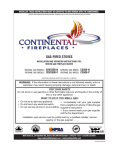
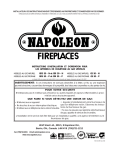
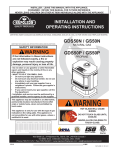
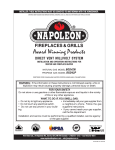

![Poêle Napoléon GDS-50 Manuel Fr [1,94 Mo]](http://vs1.manualzilla.com/store/data/006325625_1-11e6adef1757e26e6e76721e06a75284-150x150.png)
